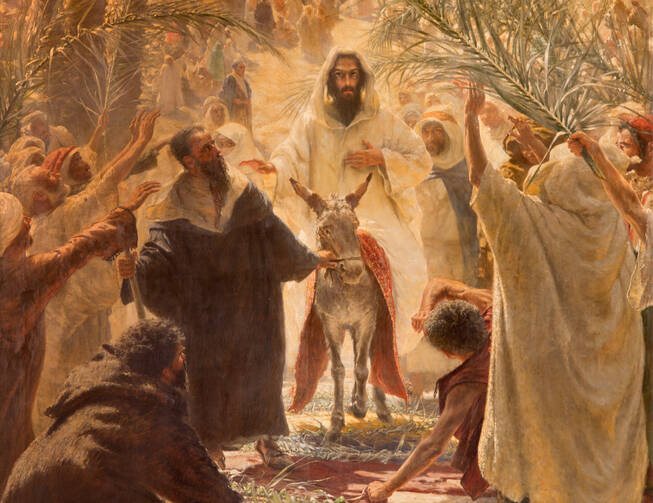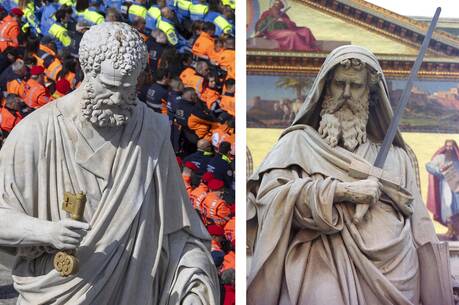Jesus died—and then rose—so you could walk together
During Holy Week, we reflect on Jesus’ final days. The readings and celebrations will be filled with emotion, both sadness at Jesus’ suffering and joy at the resurrection. The readings for Palm Sunday are robust, including two Gospels, one describing Jesus’ entry into Jerusalem and another recounting events surrounding Jesus’ crucifixion and death. The Gospels call us to reflect on Jesus’ sacrifice, highlighting several notable supporters who offered service along the way.
They took palm branches and went out to meet him, and cried out: ‘Hosanna!’ (Jn 12:13)
What are the implications of faith in Christ’s death and resurrection?
How do you live out a call to serve others?
How will you continue to grow in faith when the season of Lent ends?
Several groups and individuals are helpful to reflect on this week: the crowds who usher Jesus into Jerusalem, the woman who anoints Jesus, the centurion who proclaims Jesus’ divinity, the women who witness the crucifixion and Joseph of Arimathea, who takes Jesus’ body.
The Gospel proclaimed at the beginning of Mass will come from either Mark or John, and it describes the scattering of leafy palm branches on Jesus’ path, which is celebrated today on Palm Sunday. The people spreading palms and cloaks offer a triumphant entry for Jesus, confirming the importance of his arrival.They shout “Hosanna,” meaning “Save us,” signalling that Jesus’ work in Jerusalem is for salvation.
In his final days, Jesus is anointed by a woman at Bethany. She uses expensive perfumed oil, anointing Jesus’ head even when scolded by some who thought her action was wasteful.
Not only does she minister to Jesus, but the woman’s action anticipates his death and burial. Importantly, she visually declares Jesus as the Christ, which literally means the anointed one. Jesus praises her for her kindness and service to him, calling for her action to be remembered.
After Judas’s betrayal, Jesus is arrested and crucified. According to Mark, he is beaten, mocked and crowned with thorns before his crucifixion, suffering physical and emotional trauma on the way to death. When Jesus is finally crucified, Mark poignantly depicts the earth in mourning, as darkness fills the land. After Jesus breathes his last breath on the cross, the Roman centurion proclaims, “Truly this man was the Son of God!”
The centurion’s declaration is carefully timed in the larger context of the Gospel. On multiple occasions in Mark, Jesus has tried to keep his identity a secret, and up until this moment, no person in the Gospel had acclaimed Jesus as the Son of God. At Jesus’ baptism, the Father in heaven declared Jesus as God’s Son (Mk 1:11), and during an exorcism an unclean spirit shouts that Jesus is the Son of God (Mk 3:11). Jesus quickly rebukes the spirit, not wanting his identity known at that time. Finally, in death, this theological assertion is revealed, suggesting that Jesus as the Son of God dying on the cross is the ultimate example of God’s love for humanity. Beautifully, after much suspense, Mark has the climactic revelation proclaimed by a gentile from outside of the community, articulating Jesus’ death on the cross as salvation for all.
While many of the onlookers were antagonistic to Jesus, Mary Magdalene, Salome, Mary the mother of James and Joses and other women stayed with Jesus, faithfully supporting him when others fled. They are witnesses to salvation, and Mark emphasizes their devotion at the cross and throughout Jesus’ journey.
At the end of the Gospel, a council member from Arimathea named Joseph approaches Pilate to receive Jesus’ body. Little is known of him, although Matthew and John say that Joseph was a disciple. Joseph offers a tomb for Jesus’ body, showing generosity and care for a proper burial.
During this final week of Lent, think about the magnitude of Jesus’ sacrifice and the implications of it as a saving act of divine love. Also, reflect on the people, many of whom were unnamed in the Gospel, who walked with Jesus. These supporters offer us models for how we should live as Christian witnesses. The crowds welcomed Jesus and proclaimed his power and significance. The woman of Bethany tends to Jesus’ physical needs before death, and Joseph tends to his body after death. The centurion proclaims Jesus as the divine Son, spreading the Gospel to the community. The named and unnamed women are Christian witnesses who continually support Jesus even in death. Each freely offers service to Christ, and they remind us that faithful service is central to discipleship.
This article also appeared in print, under the headline “Faithful Service,” in the March 2021, issue.









